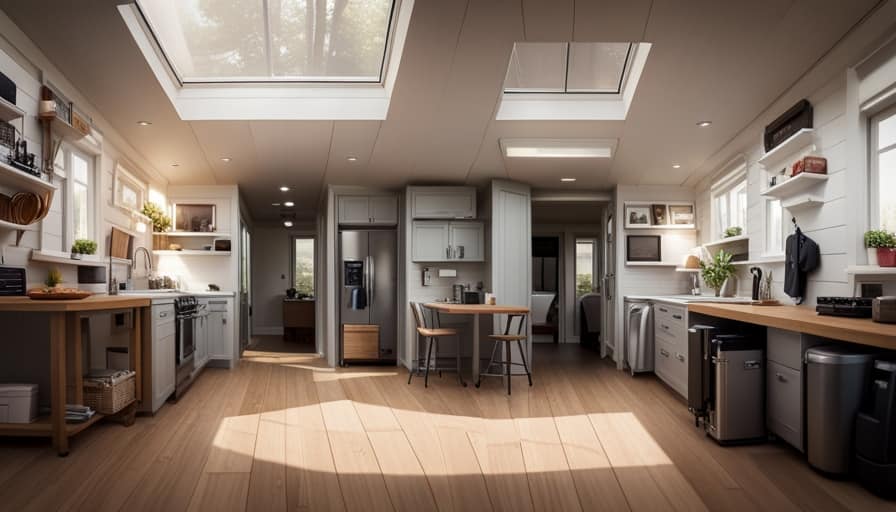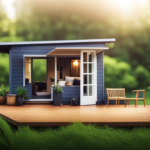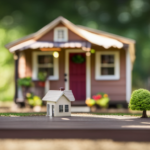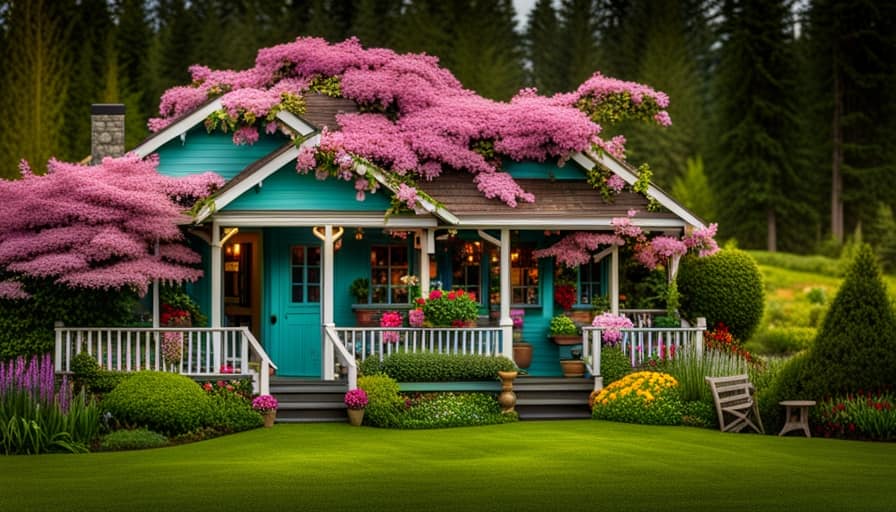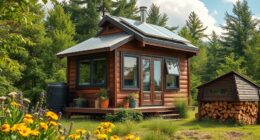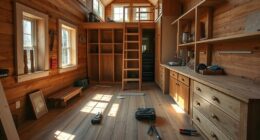Are you prepared to sell your small house and make the most of your earnings? You’re in the right place! We have all the advice and techniques to help you excel in the small housing market.
From cleaning and decluttering to negotiating the sale, we’ll guide you every step of the way. With our expert advice, you’ll be able to choose the right price, take stunning photos, and list your tiny house on the best marketplace.
Get ready to make a big impact in the tiny house world!
Key Takeaways
- Clean, declutter, and repair the tiny house to make it more appealing to potential buyers.
- Take high-quality photos and list the tiny house on a marketplace to attract interested buyers.
- Utilize social media advertising and engage with followers to reach a wider audience and increase the chances of a successful sale.
- Maximize curb appeal, stage the tiny house, and highlight its unique features and benefits to make it stand out from other listings.
Clean and Declutter Your Tiny House
Let’s start by clearing out and tidying up our tiny house to attract potential buyers. When it comes to selling a tiny house, decluttering is key. Begin by removing any unnecessary items and getting rid of clutter. This will create a sense of spaciousness and allow potential buyers to envision themselves living in the space.
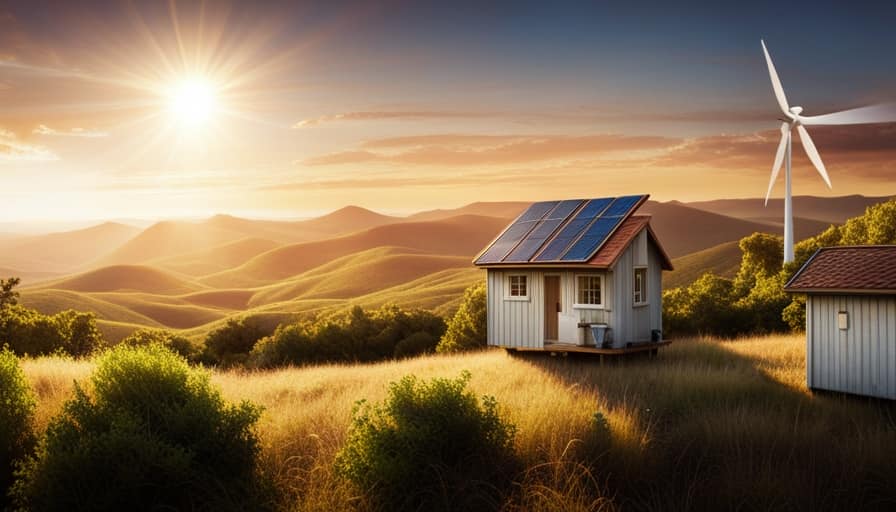
Utilize clever storage solutions to maximize the available space and showcase the functionality of the house. Implementing organizing strategies such as using bins, baskets, and shelves can help keep things neat and tidy. Remember to keep surfaces clear and clean, as this will make the house appear well-maintained and inviting.
By decluttering and organizing your tiny house, you’re setting the stage for a successful sale.
Now, let’s move on to the next step: repairing any damage.
Repair Any Damage
Now that we’ve decluttered and organized our tiny house, we need to assess and repair any damage.

Repairing any damage is crucial in preparing your tiny house for sale. Not only will it increase the value of your property, but it will also attract potential buyers who are looking for a well-maintained and sturdy home.
When it comes to repairing any damage, it’s important to consider the repair costs. Take the time to evaluate the extent of the damage and determine if it’s something you can fix on your own or if you need to hire a professional contractor.
Researching and finding reliable contractors is essential to ensure that the repairs are done correctly and within your budget.
Choose a Competitive Price
When it comes to selling your tiny house, choosing a competitive price is crucial. By implementing effective pricing strategies, you can attract potential buyers and stand out in the market.

Conducting thorough market research will help you understand the current demand and pricing trends, allowing you to set a price that’s both competitive and profitable.
Pricing Strategies
Although we want to maximize our profit, it’s important to choose a competitive price for our tiny house. Pricing strategies play a crucial role in attracting potential buyers and standing out in the market.
To determine the right price, we need to consider various factors, such as the cost of materials, labor, and any additional features or upgrades. Additionally, it’s essential to research the current market trends and analyze the prices of similar properties. This will help us understand the competition and set a price that’s both appealing to buyers and ensures a fair return on investment.
Market Research
To ensure we choose a competitive price for our tiny house, we’ll conduct market research and analyze similar properties in order to set a fair and attractive price. By identifying our target audience and analyzing market trends, we can determine the best price range that will appeal to potential buyers.

Here’s how we’ll approach our market research:
-
Identify our target audience: We’ll determine who our ideal buyers are and what they value in a tiny house. This will help us understand their price sensitivity and what they’re willing to pay.
-
Analyze market trends: We’ll study the current trends in the tiny house market, including the prices of similar properties that have been sold recently. This will give us an idea of the price range that’s competitive and in demand.
-
Set a fair and attractive price: Based on our research, we’ll set a price that’s fair for both us as sellers and attractive to our target audience. We want to ensure that our tiny house stands out in the market and offers good value for the price.
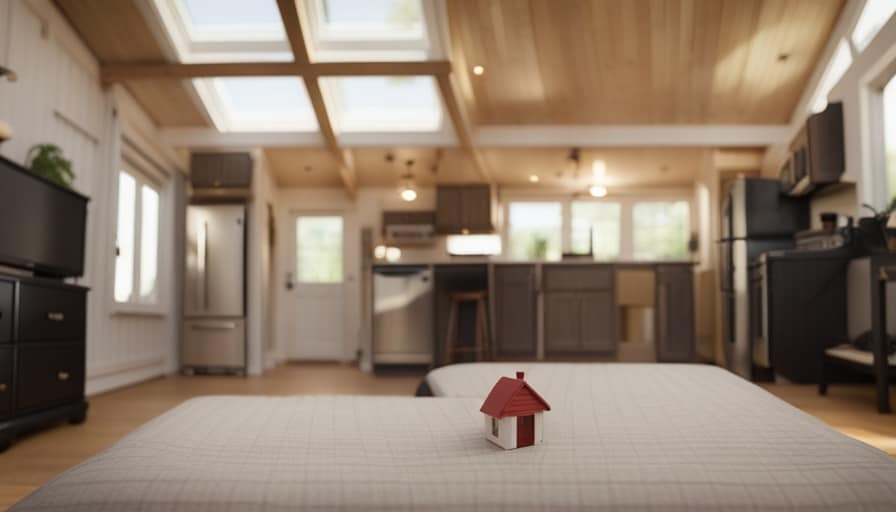
Take High Quality Photos
We love capturing stunning images that showcase the best features of our tiny house. When it comes to selling your tiny house, high-quality photos are essential. They’re the first impression potential buyers have, and can make or break a sale.
To ensure your photos stand out, follow these tips for staging your tiny house. Clear the clutter, organize your space, and highlight the unique aspects of your home. Use natural lighting to your advantage and consider adding some props to make the space feel lived-in.
Additionally, don’t forget to write an effective listing description that complements your photos. Be descriptive, highlight key features, and use persuasive language to entice potential buyers.
With stunning photos and a compelling description, you’ll be well on your way to selling your tiny house successfully.

List Your Tiny House on a Tiny House Marketplace
Once we’ve taken high-quality photos and written a compelling listing description, it’s time to list our tiny house on a tiny house marketplace. This is where potential buyers interested in tiny living will be searching for their dream home.
To ensure success, here are three key steps to follow:
-
Choose the right marketplace: Research and select a reputable platform that specializes in tiny house sales. Look for features like user-friendly interfaces, secure payment options, and a wide reach to attract potential buyers.
-
Craft an enticing listing: Highlight the unique features of your tiny house, such as energy-efficient appliances, clever storage solutions, and any custom design elements. Also, include information about tiny house financing options and any special marketing strategies you plan to offer, such as free delivery or a discounted price.
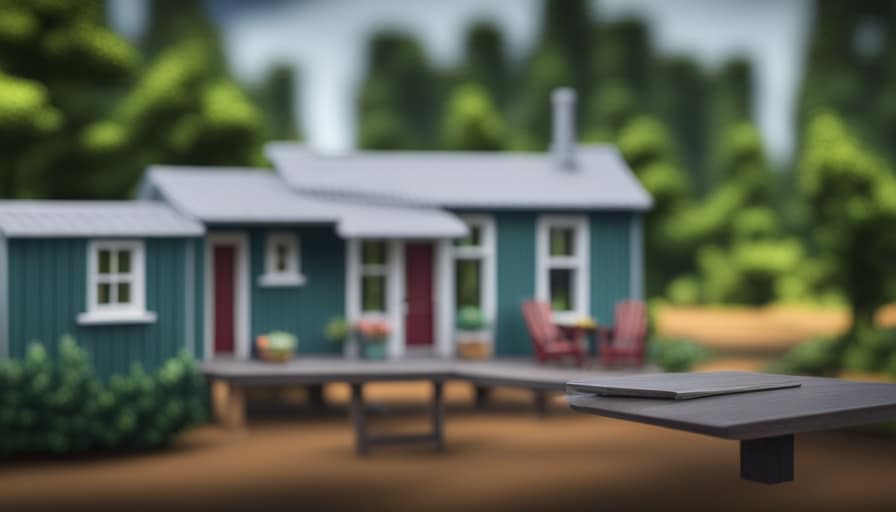
-
Engage with potential buyers: Respond promptly to inquiries, provide additional information and photos when requested, and be open to negotiations. Building a good relationship with potential buyers will increase the likelihood of a successful sale.
Promote Your Tiny House on Social Media
When it comes to selling your tiny house, social media can be a powerful tool. Through targeted advertising and engaging with followers, you can reach a wider audience and generate more interest in your property.
Social Media Advertising
Let’s start by exploring the benefits of promoting your tiny house on social media.
Social media advertising offers a plethora of advantages that can help you reach your target audience effectively. Here are three reasons why you should consider using this platform to showcase your tiny house:

-
Social media targeting: With advanced targeting options, you can reach potential buyers who are specifically interested in tiny houses. Platforms like Facebook and Instagram allow you to target individuals based on their location, interests, and demographics, ensuring your content reaches the right people.
-
Creating compelling content: Social media provides an opportunity to create visually appealing and engaging content that highlights the unique features of your tiny house. You can use high-quality images, videos, and compelling captions to capture the attention of potential buyers and showcase the lifestyle your tiny house offers.
-
Building brand awareness: By consistently promoting your tiny house on social media, you can build brand awareness and establish yourself as an authority in the tiny house market. This will help you attract a larger following and increase the chances of selling your tiny house.
As you begin promoting your tiny house on social media, it’s essential to engage with your followers and establish a connection with them.

Engaging With Followers
As we engage with our followers on social media, we can effectively promote our tiny house and connect with potential buyers. Follower engagement is crucial in building a community and establishing trust with our audience. By actively interacting with our followers, we can create a sense of belonging and foster a loyal customer base. Social media platforms provide us with an opportunity to showcase the unique features and benefits of our tiny house, while also sharing valuable content that resonates with our target market. Through regular updates, behind-the-scenes glimpses, and interactive posts, we can create a buzz around our tiny house and generate interest. By building a community of engaged followers, we can increase our chances of finding the perfect buyer for our tiny house.
| Benefits of Follower Engagement | How to Engage with Followers | Examples of Engaging Content |
|---|---|---|
| Builds trust and credibility | Respond to comments and messages | Behind-the-scenes videos and photos |
| Creates a sense of community | Run contests and giveaways | Q&A sessions and live streams |
| Generates word-of-mouth marketing | Share user-generated content | Inspiring stories and testimonials |
Offer Open Houses for Potential Buyers
We can arrange open houses to showcase our tiny house to potential buyers. Hosting open houses offers several benefits that can help us sell our tiny house quickly and effectively:
-
Increased exposure: Open houses attract a wide range of potential buyers, allowing us to reach a larger audience and increase the chances of finding the right buyer for our tiny house.
-
Hands-on experience: Open houses provide an opportunity for potential buyers to experience our tiny house firsthand. They can explore the layout, appreciate the craftsmanship, and envision themselves living in the space.

-
Personal connection: Meeting potential buyers face-to-face during open houses allows us to establish a personal connection, answer their questions, and address any concerns. This interaction can build trust and confidence in our tiny house.
To plan a successful open house, we should consider factors such as timing, advertising, staging, and preparing informational materials. By hosting open houses, we can effectively showcase our tiny house and increase the chances of finding the perfect buyer.
Negotiate the Sale of Your Tiny House
Our main goal is to find the right buyer for our tiny house, so we’ll need to carefully negotiate the terms of the sale. Negotiation tactics play a crucial role in ensuring a successful transaction.
First, it’s important to set boundaries and determine your minimum acceptable price. This will help you stay firm during negotiations and avoid settling for less than what your tiny house is worth.
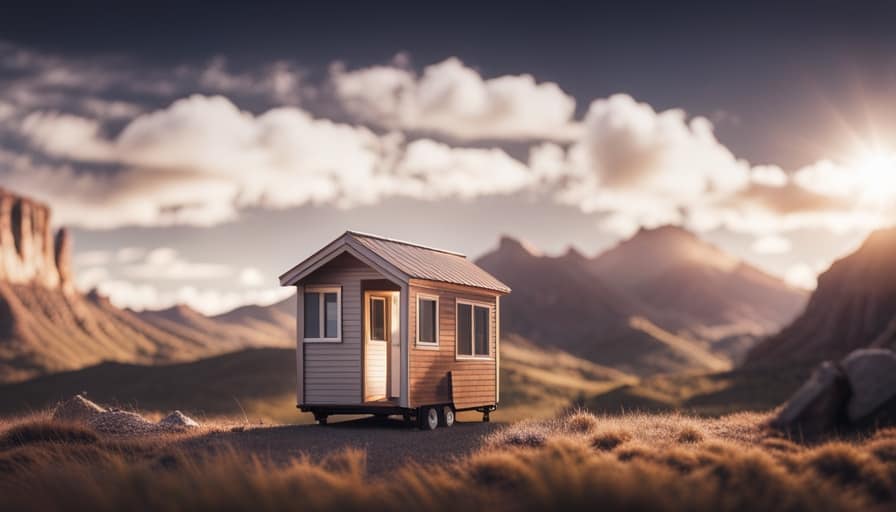
Additionally, be prepared to offer incentives or concessions that can sweeten the deal for potential buyers. This could include including certain furniture or appliances in the sale, or even offering a flexible closing date.
Arrange for Delivery or Pick-Up
To ensure a smooth transaction, we need to make arrangements for the delivery or pick-up of the tiny house. Here are some key steps to consider:
-
Delivery options: Determine the best method of delivering the tiny house to the buyer. This could involve hiring a professional transport service or utilizing a flatbed trailer. Consider the distance, cost, and logistics involved in each option.
-
Organizing showings: If the buyer prefers to pick up the tiny house themselves, it’s important to schedule showings at a convenient time. Coordinate with the buyer to find a date and time that works for both parties. Make sure the tiny house is clean and presentable for potential buyers.
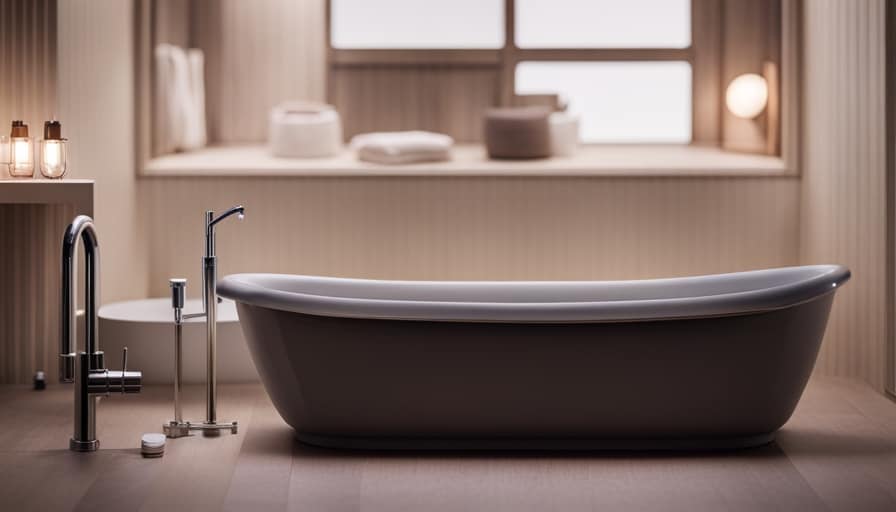
-
Finalizing the details: Before delivery or pick-up, ensure that all necessary paperwork is in order. This includes transferring ownership, providing any required documentation, and settling payment terms. Communicate clearly with the buyer to avoid any misunderstandings.
Finalize the Paperwork for the Sale
Once we’ve reached an agreement on the sale of the tiny house, it’s crucial to finalize all the necessary paperwork. Finalizing the paperwork for the sale involves fulfilling legal requirements, drafting contracts, and going through the closing process. This step ensures that both the seller and the buyer are protected and that the transaction is legally binding.
To begin, it’s important to verify the buyer’s financing and pre-approval status. This will help ensure that the buyer has the necessary funds to complete the purchase. Once this has been confirmed, the next step is to draft the necessary contracts. These contracts should include all the details of the sale, such as the purchase price, payment terms, and any additional agreements made between the buyer and the seller.
Finally, the closing process will involve reviewing and signing all the paperwork, transferring ownership, and exchanging funds. It’s essential to carefully review all the documents and seek legal advice if needed to ensure a smooth and successful sale.

Maximize Your Profits: Tips and Tricks for Selling Your Tiny House
When it comes to selling your tiny house, we can maximize our profits by implementing these tips and tricks.
First, focus on maximizing curb appeal. Ensure that the exterior of your tiny house is clean, well-maintained, and visually appealing. This includes landscaping, painting, and repairing any visible damages.
Second, stage your tiny house to showcase its potential. Create a cozy and inviting atmosphere that allows potential buyers to envision themselves living there. Use neutral colors, declutter, and arrange furniture strategically to maximize space.
Lastly, highlight the unique features and benefits of your tiny house. Emphasize its energy efficiency, low maintenance, and cost-saving advantages.

Frequently Asked Questions
How Do I Find Potential Buyers for My Tiny House?
To find potential buyers for our tiny house, we utilize effective tiny house marketing strategies. We conduct thorough target market analysis to identify individuals who are interested in downsizing and living a minimalist lifestyle.
What Documents Do I Need to Finalize the Sale of My Tiny House?
To finalize the sale of your tiny house, you’ll need a few key documents: a purchase agreement, bill of sale, and any necessary permits. It’s important to fulfill your legal obligations and ensure a smooth transaction.
Are There Any Legal Considerations or Regulations I Should Be Aware of When Selling a Tiny House?
When selling a tiny house, it’s crucial to be aware of legal considerations and regulations. Zoning restrictions and building codes may vary, so it’s important to research and comply with local laws to ensure a smooth and legal sale.
How Can I Effectively Negotiate the Price of My Tiny House With Potential Buyers?
When it comes to negotiating the price of our tiny house with potential buyers, we employ effective negotiation strategies and consider various pricing factors. This ensures a fair and successful transaction for both parties involved.

What Are Some Common Mistakes to Avoid When Selling a Tiny House?
When selling a tiny house, common mistakes can be avoided by implementing effective pricing strategies. By understanding the market, highlighting unique features, and setting a realistic price, sellers can attract potential buyers and maximize their profit.
Conclusion
In conclusion, by following these steps, we can successfully navigate the miniature market and sell our tiny house for maximum profits.
By cleaning, repairing, and decluttering our tiny house, we can attract potential buyers.
Setting a competitive price and taking high-quality photos will further enhance our chances of making a successful sale.

Listing our tiny house on a reputable marketplace and negotiating effectively will ensure a smooth transaction.
Finally, arranging for delivery or pick-up and finalizing the paperwork will complete the selling process.
With these tips and tricks, we can confidently sell our tiny house and maximize our profits.
I’m Theodore, and I love tiny houses. In fact, I’m the author of Tiny House 43, a book about tiny houses that are also tree houses. I think they’re magical places where imaginations can run wild and adventures are just waiting to happen.
While tree houses are often associated with childhood, they can be the perfect adult retreat. They offer a cozy space to relax and unwind, surrounded by nature. And since they’re typically built on stilts or raised platforms, they offer stunning views that traditional homes simply can’t match.
If you’re looking for a unique and romantic getaway, a tree house tiny house might just be the perfect option.

